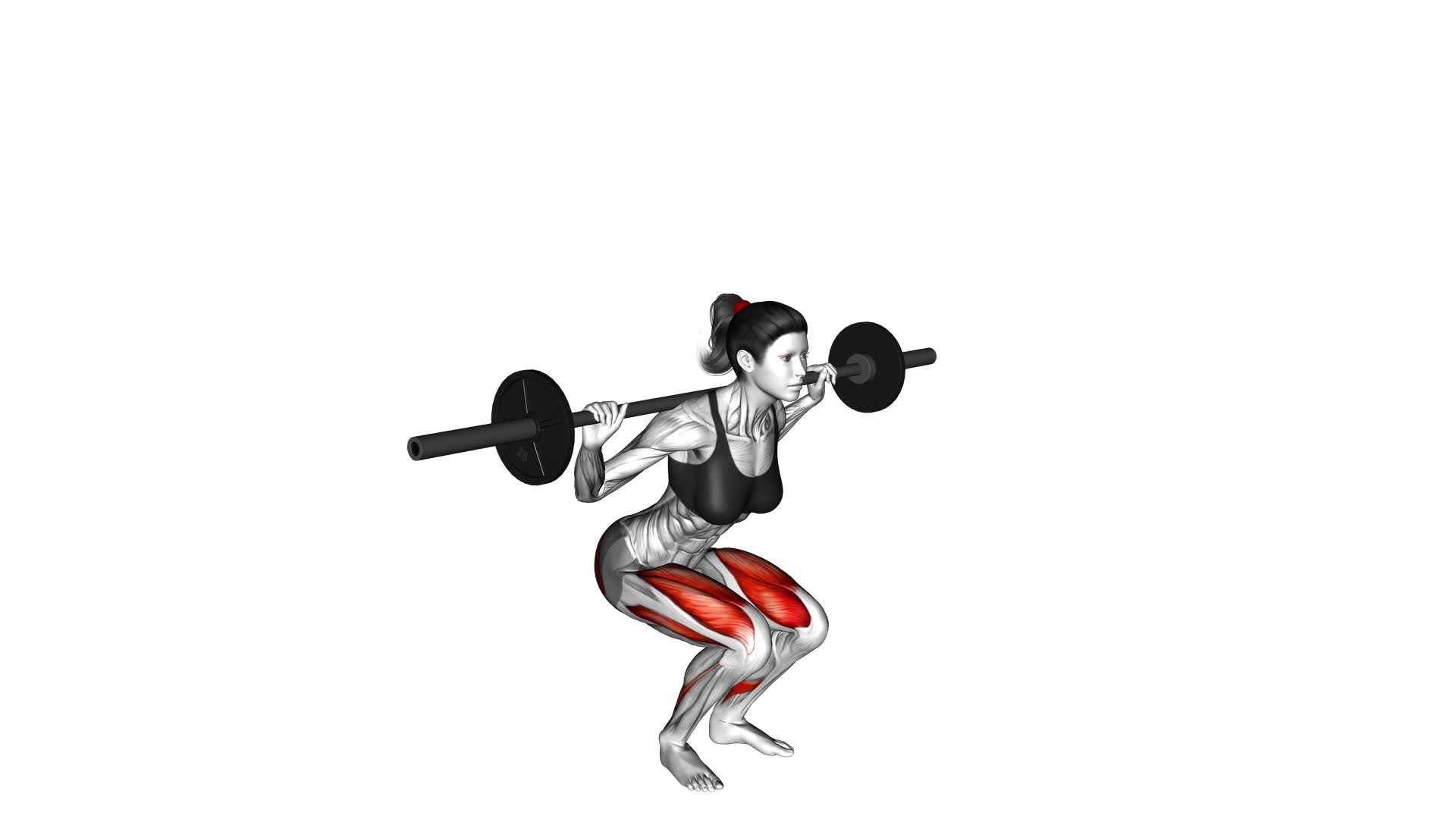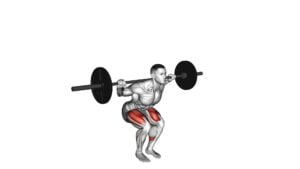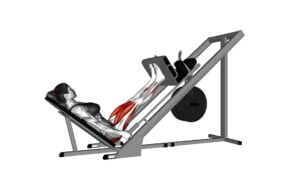Barbell Narrow Stance Squat (female) – Video Exercise Guide & Tips

Are you looking to maximize your leg strength and muscle engagement? Then the Barbell Narrow Stance Squat is the exercise for you!
Watch This Exercise Video
In this video exercise guide, we'll show you the proper equipment and set-up, along with step-by-step execution of the exercise.
We'll also cover common mistakes to avoid and provide tips for getting the most out of this powerful squat variation.
Get ready to feel the burn and take your leg workouts to the next level!
Key Takeaways
- Increases leg strength and muscle engagement
- Targets quadriceps, hamstrings, and glutes
- Improves core stability and balance
- Allows for adjustable weight and intensity
Benefits of the Barbell Narrow Stance Squat
You can experience significant strength gains by incorporating the Barbell Narrow Stance Squat into your workout routine. This exercise offers numerous benefits and targets multiple muscle groups for optimal muscle engagement.
One of the key benefits of the Barbell Narrow Stance Squat is its ability to strengthen your lower body. By performing this exercise, you engage your quadriceps, hamstrings, and glutes, helping to develop strong and powerful legs. Additionally, the narrow stance requires greater stability, which activates the muscles in your core and improves your overall balance.
Another advantage of the Barbell Narrow Stance Squat is its versatility. You can adjust the weight on the barbell to suit your fitness level and gradually increase the intensity as you progress. This allows you to continually challenge and stimulate your muscles, leading to more significant gains over time.
Furthermore, this exercise promotes functional strength, which translates into improved performance in daily activities and sports. The compound nature of the Barbell Narrow Stance Squat strengthens not only your legs but also your hip flexors and lower back. This can enhance your overall athleticism and prevent injuries by improving your body's ability to move efficiently and maintain proper form.
Incorporating the Barbell Narrow Stance Squat into your workout routine can offer a wide range of benefits, including increased strength, improved muscle engagement, and enhanced functional performance.
Now let's move on to the next section, where we'll discuss the proper equipment and set-up for this exercise.
Proper Equipment and Set-Up
To properly set up for the Barbell Narrow Stance Squat, gather the necessary equipment and position yourself in the correct stance. Here's what you need and how to prepare:
- Equipment selection: Choose a barbell that's appropriate for your strength level and fitness goals. Make sure it's loaded with an appropriate amount of weight for your capabilities. Additionally, select a sturdy squat rack or power rack to safely perform the exercise.
- Warm-up routine: Before starting the Barbell Narrow Stance Squat, it's crucial to warm up your muscles and joints to prevent injuries. Begin with some light cardio exercises, such as jogging or cycling, to increase your heart rate and improve blood flow. Then, perform dynamic stretching exercises that target the muscles involved in the squat, such as hip swings and leg swings.
- Stance positioning: Stand with your feet shoulder-width apart, toes slightly pointed outward. Position the barbell on your upper back, resting it securely on your trapezius muscles. Ensure your chest is lifted, shoulders are pulled back, and core is engaged.
Step-by-Step Execution of the Exercise
To perform the Barbell Narrow Stance Squat with proper form and technique, start by standing with your feet shoulder-width apart and the barbell resting on your upper back. Lower your body by bending at the knees and hips, keeping your back straight and your chest up.
Avoid common mistakes such as rounding your back, leaning forward excessively, or letting your knees cave inward.
Proper Form and Technique
To ensure proper form and technique for the barbell narrow stance squat (female), it's important that you maintain a stable and controlled movement throughout the exercise. Here are some key points to keep in mind:
- Position your feet shoulder-width apart, with your toes slightly turned out.
- Grab the barbell with an overhand grip, placing it on the back of your shoulders.
- Keep your chest up, core engaged, and shoulders pulled back as you lower your hips down and back, bending your knees.
Common misconceptions: It's often believed that squatting with a narrow stance may put excessive strain on the knees. However, when performed correctly, this exercise can actually help improve knee stability and control.
Modifications and adaptations: Beginners or those with limited mobility can start by using a lighter weight or performing the exercise without any weight until they feel comfortable and confident in their form. Adding a resistance band around the knees can also help activate the glutes and promote proper alignment.
Common Mistakes to Avoid
One common mistake to avoid when performing the barbell narrow stance squat (female) is improper knee alignment. It's important to ensure that your knees are tracking in line with your toes throughout the entire movement. If your knees collapse inward or go too far forward, it can put unnecessary stress on your knee joints and increase the risk of injury. To prevent this, focus on pushing your knees outwards and maintaining a stable position throughout the exercise.
Another mistake to avoid isn't activating the correct muscles. Make sure to engage your glutes, hamstrings, and quadriceps to maximize muscle activation and get the most out of the exercise.
By avoiding these common mistakes, you can perform the barbell narrow stance squat safely and effectively.
Now, let's move on to discuss more common mistakes to avoid.
Common Mistakes to Avoid
Avoid these common mistakes when performing the Barbell Narrow Stance Squat exercise. To ensure proper form and maximize the benefits of this exercise, be mindful of the following common errors:
- Leaning too far forward: One common mistake is leaning excessively forward during the squat. This places excessive strain on your lower back and reduces the engagement of your leg muscles. Maintain an upright posture throughout the movement to avoid this error.
- Not going low enough: Another mistake isn't squatting low enough. Failing to reach a proper depth limits the activation of your glutes and hamstrings. Aim to lower your hips until your thighs are parallel to the ground or slightly below, while maintaining good form.
- Allowing knees to cave in: Allowing your knees to cave inward is a common error that can lead to knee pain and instability. To avoid this, focus on driving your knees outwards during the squat. This helps engage your glutes and ensures proper alignment of your lower body.
By being aware of these common mistakes and striving for proper form, you can maximize the effectiveness of the Barbell Narrow Stance Squat exercise and reduce the risk of injury.
Remember to start with light weights and gradually increase the load as you become more comfortable with the movement.
Tips for Maximizing Muscle Engagement
How can you effectively engage your muscles during the Barbell Narrow Stance Squat exercise? Maximizing muscle activation is crucial to getting the most out of your workout. To achieve this, there are a few key muscle engagement techniques you can implement.
Firstly, focus on maintaining proper form throughout the exercise. Keep your core engaged and your back straight to ensure that your muscles are being targeted effectively. This will help to prevent any unnecessary strain on your lower back and maintain stability.
Secondly, make sure to activate your glutes and quadriceps during the movement. To do this, push through your heels as you rise from the squat position, engaging your glutes to power the movement. Additionally, concentrate on squeezing your quadriceps at the top of the squat to maximize muscle engagement.
Another technique is to control the descent of the squat. By lowering yourself slowly and under control, you're forcing your muscles to work harder and engage more effectively. This will enhance muscle activation and overall strength gains.
Lastly, consider incorporating resistance bands or weights into your narrow stance squat routine. Adding external resistance will increase the demand on your muscles, leading to greater muscle activation and growth.
Progression and Variations of the Exercise
To progress and vary the barbell narrow stance squat, there are three key points to consider.
Firstly, you can gradually increase the weight you're lifting to challenge your muscles and build strength.
Secondly, you can experiment with different foot positions, such as placing your feet closer together or slightly wider, to target different muscles in your lower body.
Lastly, as you become more advanced, you can try advanced squat variations like pistol squats or Bulgarian split squats to further challenge your balance, stability, and strength.
Increasing Weight Safely
Are you ready to safely increase the weight for your Barbell Narrow Stance Squat? Before adding more weight to your routine, it's essential to take safety precautions and ensure you have an effective warm-up. Here are some tips to help you increase the weight safely:
- Gradual Progression: Increase the weight gradually to allow your muscles to adapt and minimize the risk of injury.
- Proper Form: Focus on maintaining proper form throughout the exercise, even when increasing the weight. This will help you engage the targeted muscles effectively and reduce the risk of strain.
- Warm-Up: Before starting your workout, perform dynamic stretches and movements to warm up your muscles and increase blood flow, preparing your body for the added weight.
Different Foot Positions
To continue building upon your progress and safely increasing the weight for your Barbell Narrow Stance Squat, let's explore the various foot positions that can be used to progress and vary the exercise.
Different foot positions can provide unique benefits and challenge different muscle groups. One variation is the narrow stance, where your feet are positioned closer together than shoulder-width apart. This position activates the quadriceps, glutes, and hamstrings to a greater extent than a wider stance. It also improves stability and balance, allowing for more control during the squat.
The narrow stance targets the inner thighs and helps to develop stronger adductor muscles. By incorporating different foot positions, you can further enhance your squatting technique, improve overall leg strength, and maximize your workout effectiveness.
Advanced Squat Variations
Now, let's progress to more challenging squat variations to further enhance your leg strength and maximize your workout effectiveness.
Here are three advanced front squat variations that you can incorporate into your squat training program:
- Pause Front Squats: Perform a regular front squat, but pause for a brief moment at the bottom of the movement. This will increase time under tension and enhance muscle activation.
- Single Leg Front Squats: Elevate one foot behind you and perform a front squat using your other leg. This variation adds an element of balance and stability, targeting each leg individually.
- Overhead Front Squats: Hold a barbell overhead while performing a front squat. This variation engages your core, shoulders, and upper back in addition to your legs.
Incorporating these advanced front squat variations into your training program will challenge your muscles in new ways, leading to increased strength and overall fitness.
Frequently Asked Questions
How Many Sets and Reps Should I Do When Performing the Barbell Narrow Stance Squat?
When performing the barbell narrow stance squat, the number of sets and reps will depend on your fitness level and goals. As a general guideline, aim for 3-4 sets of 8-12 reps. However, it's important to listen to your body and adjust accordingly.
If you're a beginner, start with lighter weights and fewer reps. As you progress, you can increase the weight and reps. Remember to consult with a fitness professional for personalized advice and variations of the narrow stance squat for different fitness levels.
Can I Use Dumbbells Instead of a Barbell for the Narrow Stance Squat?
Yes, you can use dumbbells as an alternative to a barbell for the narrow stance squat. This exercise targets your quads, glutes, and hamstrings. By using dumbbells, you can increase the stabilization required in your core and other smaller muscles.
Additionally, using dumbbells allows for a wider range of motion, which can further engage your muscles. Overall, the narrow stance squat with dumbbells offers similar benefits to the barbell version.
Is It Normal to Feel Discomfort in My Knees During the Exercise?
Feeling discomfort in your knees during exercise isn't uncommon. It could be due to improper form or placing too much stress on your knees.
Make sure your knees are aligned with your toes and avoid letting them cave inwards. Additionally, focus on keeping your weight in your heels and maintaining a stable core.
If the discomfort persists, consider consulting with a fitness professional to ensure you're performing the exercise correctly and safely.
Should I Wear a Weightlifting Belt When Performing the Barbell Narrow Stance Squat?
When performing the barbell narrow stance squat, wearing a weightlifting belt is a personal choice. It can provide support and stability to your core, helping you maintain proper form and prevent injury.
However, it's important to note that a weightlifting belt won't directly alleviate knee discomfort. If you're experiencing knee discomfort during the exercise, it's crucial to assess your form, decrease the weight, and consult a professional if the pain persists.
How Often Should I Incorporate the Barbell Narrow Stance Squat Into My Workout Routine?
To effectively incorporate the barbell narrow stance squat into your workout routine, you need to consider your fitness goals and training schedule. This exercise targets your lower body muscles, so doing it 2-3 times a week can be beneficial. However, it's important to listen to your body and not overdo it.
As for using a barbell, it provides added resistance and helps improve strength and stability. So, yes, it's necessary to use a barbell for the narrow stance squat.
Conclusion
To maximize muscle engagement and reap the benefits of the barbell narrow stance squat, proper equipment and set-up are crucial. By following the step-by-step execution and avoiding common mistakes, individuals can effectively target their lower body muscles.
Progression and variations of this exercise can further enhance its effectiveness. With precise form and technique, females can confidently incorporate this exercise into their fitness routine for improved strength and muscle development.

Author
Years ago, the spark of my life’s passion ignited in my mind the moment I stepped into the local gym for the first time. The inaugural bead of perspiration, the initial endeavor, the very first surge of endorphins, and a sense of pride that washed over me post-workout marked the beginning of my deep-seated interest in strength sports, fitness, and sports nutrition. This very curiosity blossomed rapidly into a profound fascination, propelling me to earn a Master’s degree in Physical Education from the Academy of Physical Education in Krakow, followed by a Sports Manager diploma from the Jagiellonian University. My journey of growth led me to gain more specialized qualifications, such as being a certified personal trainer with a focus on sports dietetics, a lifeguard, and an instructor for wellness and corrective gymnastics. Theoretical knowledge paired seamlessly with practical experience, reinforcing my belief that the transformation of individuals under my guidance was also a reflection of my personal growth. This belief holds true even today. Each day, I strive to push the boundaries and explore new realms. These realms gently elevate me to greater heights. The unique combination of passion for my field and the continuous quest for growth fuels my drive to break new ground.







